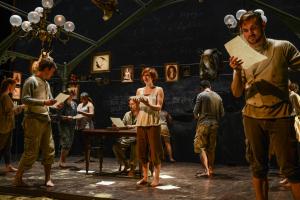Theatre Collaboration Combines Two Cultures, Two Languages in One Powerful Performance.
FOR IMMEDIATE RELEASE
August 24, 2012 – College Park, Md. -- The University of Maryland’s (UMD) School of Theatre, Dance, and Performance Studies (TDPS) crosses continents, oceans and 12 time zones with a groundbreaking bi-lingual co-production of William Shakespeare’s A Midsummer Night’s Dream. Created in collaboration with the National Academy of Chinese Theatre Arts (NACTA), the production will be presented at the Clarice Smith Performing Arts Center September 27 through September 30, 2012, under the direction of TDPS professor Mitchell Hébert and Yu Fanlin, Professor of Directing at NACTA. After its premiere run at the Center, it will travel to Beijing for a series of performances.
Two Worlds, One Vision
Two years in the making, the production features lush, brilliant costumes and dazzling sets that create a fantasy world where elements of Chinese and American performance styles, music and language come together. Each of the Chinese and American actors – Shakespeare’s lovers, fairies and trickster Puck – will speak in their own native language but will perform as if in the same tongue. Audiences will follow the dialogue through supertitles displayed on large plasma screen TVs at either side of the stage.
The Collaboration
Sets, costume designs, lighting and sound were created in partnership between the two schools. Using Skype, video drop boxes, emails and phone calls, the TDPS creative team shared their ideas, creative concepts and experiences with their distant partners. Cast members also held joint rehearsals using a new Cisco Telepresence system recently acquired by TDPS as part of a multi-year grant from the Morris & Gwendolyn Cafritz Foundation.
Origin of A Unique Idea
This never-before-done production was initiated by noted costume designer and UMD Professor Helen Huang, who first shared the idea for a co-production while teaching a master class at the National Academy of Chinese Theatre Arts in Beijing.
Huang served as cultural ambassador between the two schools as the work unfolded, enabling all aspects to come together – from delicate creative interpretation in two languages to making actors comfortable with unknown foods. “We had to find our way in uncharted territory every day,” said Huang. “Each step required thoughtful consideration.”
Two Cultures, One Extraordinary Production
Cultural interchange infuses every element of the production. TDPS students helped prepare for their Midsummer experience by taking a semester-long class on Chinese culture taught by doctoral student Robert Thompson, who is also assistant director of the play. The class delved into Chinese history, social norms, politics, gender roles and money, among other topics, to prepare for culturally appropriate interaction with their Chinese counterparts.








